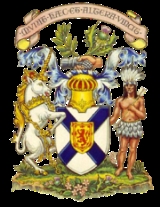
Coat of arms of Nova Scotia
Overview
Coat of arms
A coat of arms is a unique heraldic design on a shield or escutcheon or on a surcoat or tabard used to cover and protect armour and to identify the wearer. Thus the term is often stated as "coat-armour", because it was anciently displayed on the front of a coat of cloth...
of the province of Nova Scotia
Nova Scotia
Nova Scotia is one of Canada's three Maritime provinces and is the most populous province in Atlantic Canada. The name of the province is Latin for "New Scotland," but "Nova Scotia" is the recognized, English-language name of the province. The provincial capital is Halifax. Nova Scotia is the...
is the oldest provincial achievement of arms in Canada, and the oldest British coat of arms outside Great Britain. It was granted in 1625 by King Charles I
Charles I of England
Charles I was King of England, King of Scotland, and King of Ireland from 27 March 1625 until his execution in 1649. Charles engaged in a struggle for power with the Parliament of England, attempting to obtain royal revenue whilst Parliament sought to curb his Royal prerogative which Charles...
for the first Scottish colony
Scottish colonization of the Americas
Scottish colonization of the Americas consisted of a number of failed or abandoned Scottish settlements in North America, a colony at Darien, Panama, and a number of wholly or largely Scottish settlements made after the Acts of Union 1707, and those made by the enforced resettlement after the...
on the Canadian mainland. The arms were also borne by the Baronets of Nova Scotia, a chivalric order.
They fell out of use when Nova Scotia joined the Confederation
Canadian Confederation
Canadian Confederation was the process by which the federal Dominion of Canada was formed on July 1, 1867. On that day, three British colonies were formed into four Canadian provinces...
in 1867, but were restored in 1929.
The arms were originally granted in 1625 by King Charles I
Charles I of England
Charles I was King of England, King of Scotland, and King of Ireland from 27 March 1625 until his execution in 1649. Charles engaged in a struggle for power with the Parliament of England, attempting to obtain royal revenue whilst Parliament sought to curb his Royal prerogative which Charles...
as part of a Scottish settlement attempt in Nova Scotia led by Sir William Alexander
William Alexander, 1st Earl of Stirling
William Alexander, Earl of Stirling was a Scotsman who was an early developer of Scottish colonisation of Port Royal, Nova Scotia and Long Island, New York...
.

